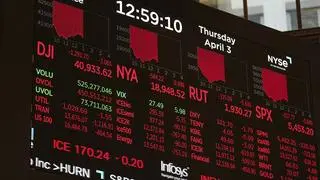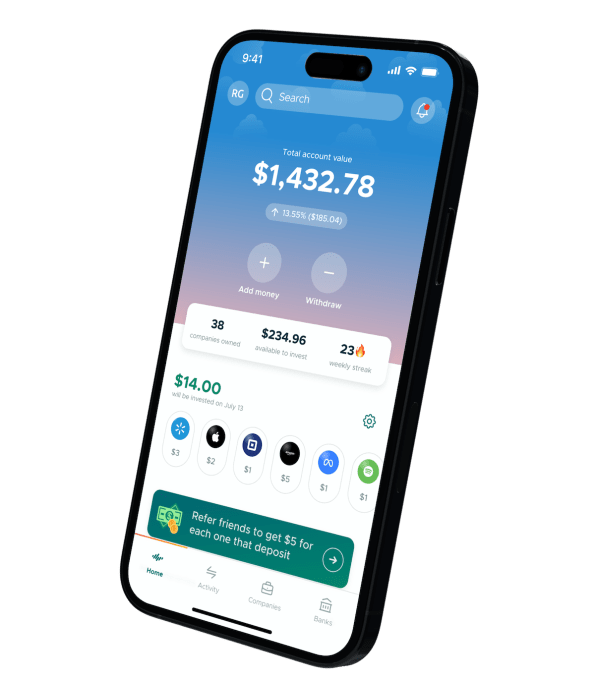
Wall Street suffered a second straight day of sharp losses on Friday, with the Nasdaq Composite officially entering a bear market and the Dow Jones Industrial Average confirming a correction.
| Photo Credit:
Wall Street nosedived for a second straight day on Friday, confirming the Nasdaq Composite was in a bear market and the Dow Jones Industrial Average was in a correction, as an escalating global trade war spurred the biggest losses since the pandemic.
The Dow Jones Industrial Average, S&P 500 and the Nasdaq Composite posted their largest two-day declines since the emerging coronavirus caused global panic during U.S. President Donald Trump’s first term. For Thursday and Friday, the Dow was down 9.3%, the S&P 500 10.5% and the Nasdaq 11.4%.
Fallout from Trump’s sweeping tariffs stoked fears of a global recession, wiping trillions of dollars of value from U.S. companies. Highlighting growing panic among investors, the CBOE Volatility Index, or Wall Street’s fear gauge, closed at its highest level since April 2020.
Since late on Wednesday, when Trump boosted tariff barriers to their highest level in more than a century, investors have dumped stocks, fearing both the new U.S. economic reality and also how U.S. trading partners might retaliate by steepening their own trade barriers.
A record-breaking number of shares were traded on Friday, with volume on U.S. exchanges around 26.79 billion shares, beating the previous high of 24.48 billion shares traded on January 27, 2021.
Indexes down: S&P 500 5.97%, Nasdaq 5.82%, Dow 5.5%
The Nasdaq slid on Friday 962.82 points, or 5.82%, to 15,587.79, confirming the tech-heavy index was in a bear market compared to its record closing high of 20,173.89 on December 16.
Meanwhile, the Dow Jones Industrial Average fell 2,231.07 points, or 5.50%, to 38,314.86 points, confirming a correction to its record closing high of 45,014.04 on December 4.
The S&P 500 lost 322.44 points, or 5.97%, to close at 5,074.08 points, its lowest finish in 11 months.
“Right now, how bad it gets depends on how committed the administration is to this set of policies which, clearly, the market is voting against,” said Steve Sosnick, chief strategist at Interactive Brokers.
Global governments began reacting to Trump’s tariff announcement on Friday, further undermining investor sentiment that a global recession could be averted. JP Morgan said it was forecasting a 60% chance of the global economy entering a recession by year-end, up from 40% previously.
China’s finance ministry said it would impose additional tariffs of 34% on all U.S. goods from April 10. Meanwhile, the prime ministers of Britain, Australia and Italy held talks on how to respond to Trump’s tariff salvo.
“We’re in the Wild West of a trade war right now,” said Mariam Adams, managing director at UBS Wealth Management.
Weekly data
For the week, the S&P 500 fell 9.1%, the Dow declined 7.9%, and the Nasdaq slumped 10%.
Federal Reserve Chair Jerome Powell spoke publicly for the first time since Trump’s tariff announcement. Powell highlighted the unexpectedly hefty tariffs could trigger higher inflation and slower growth, setting the stage for challenging decisions for U.S. central bankers.
Safe-haven buying in the bond market sent the yield on the benchmark 10-year Treasury notes to below 4%.
This pushed U.S. bank stocks down further, with the sector under pressure globally, as the prospect of interest rate cuts from central banks and a hit to economic growth from tariffs would crimp profitability. The S&P Banks index dropped 7.3%.
All 11 S&P sectors dropped by more than 4.5%, with energy the leading laggard for the second straight day, off 8.7%, as companies tracked a 7.3% decline in U.S. crude prices.
U.S.-listed shares of Chinese companies dived, with JD.com and Alibaba and Baidu all down more than 7.7%.
Companies with exposure to China also fell across the board, with mega-caps such as Apple dropping 7.3%.
The chipmakers index sank 7.6%, having declined 9.9% the previous day. The sector is particularly vulnerable to a double tariff whammy as many chip companies design their chips in the U.S., but have them manufactured in China.
More Like This
Published on April 5, 2025















